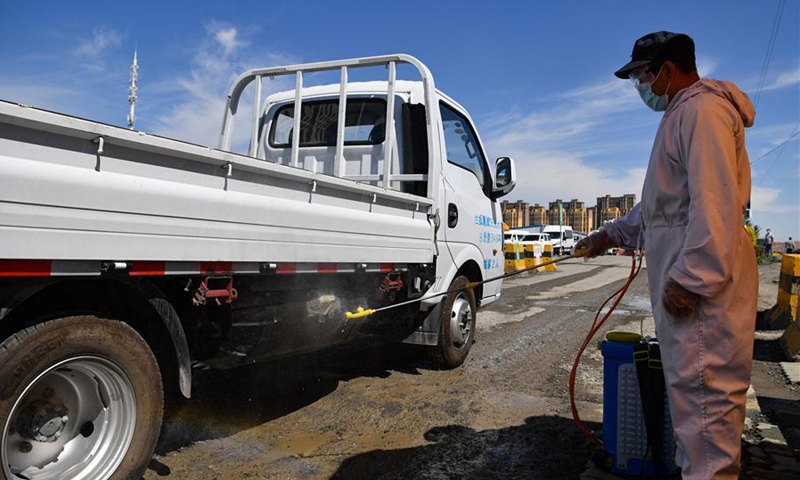New epidemic waves in two cities ‘under control,’ says official
Source: Global Times Published: 2020/8/6 0:12:14

A staff member disinfects a truck entering the Xinjiang Jiuding farm produce wholesale market at the entrance to the market in Urumqi, northwest China's Xinjiang Uygur Autonomous Region, July 29, 2020. (Xinhua/Song Yanhua)
The rapid development of the COVID-19 epidemic in the city of Dalian, Northeast China’s Liaoning Province, and Urumqi, Northwest China’s Xinjiang Uygur Autonomous Region has been controlled, an official said at a media briefing on Wednesday.
Jiao Yahui, ombudsman of the Medical Administration Bureau of the National Health Commission, introduced the situation on improved nucleic acid testing at the media briefing held by the State Council Information Office. According to Jiao, the rapid development of the COVID-19 epidemic in the two cities has been brought under control, with related prevention, treatment, and tracing becoming orderly. Jiao also summarized a few similarities shared by the two waves, and reviewed the work done in epidemic prevention.
From July 16 to August 4, Liaoning reported 90 confirmed cases, while Xinjiang registered 670 cases.
The city of Dalian, Liaoning registered zero new confirmed cases, local health officials announced on Wednesday, for the first time in the past two weeks.
Xinjiang reported 22 new cases on Wednesday, showing a daily decline over the past week.
According to Jiao, the epidemic waves in Dalian and Urumqi have a few common features. First, the development was relatively rapid in the early stages. Since the first case was reported in Urumqi in the middle of July, the number of people diagnosed surpassed 550 within the following two weeks. Similarly, since the first case was reported in Dalian, the number of cases exceeded 100 in less than 10 days.
Second, it was most often diagnosed in young and middle-aged people. The average age of cases in Urumqi was 35, while that of the Dalian cases was 41. A younger age showed that these cases are mainly mild and common infections. Therefore, the overall condition is relatively controllable.
Jiao reviewed the work that has been done while fighting the new epidemic waves in the two cities, including applying city-wide nucleic acid testing and using convalescent patients’ plasma for treatment.
The National Health Commission organized and sent 21 nucleic acid testing medical teams of over 400 people from 12 provinces to Urumqi to help conduct nucleic acid testing citywide.
At the same time, epidemiological investigations were conducted quickly to identify potential sources of infection.
The nucleic acid testing capability was quickly strengthened in the two cites in order to detect the largest possible number of infected people and cases of infection.
Every possible effort has been made to improve the effectiveness of medical treatment. Local hospital systems designated hospitals and medical forces, while medical and nursing forces from top hospitals were assigned to take care of COVID-19 patients, maximizing the effectiveness of medical treatment.
In addition, 116,000 milliliters of convalescent patients’ plasma and 250 immunoglobulins were allocated from Hubei, Beijing, and other provinces to strengthen the treatment of patients, especially those with severe symptoms.
Through comprehensive measures, the rapid development of the epidemic in the two cities has been effectively controlled. For the time being, prevention, treatment, and tracing are all showing orderly progress, Jiao said.
Posted in: SOCIETY